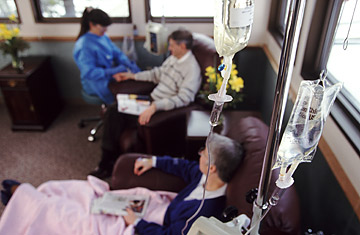
For the first time since researchers began reporting national data on cancer, the statistics in a new report show that the rate of newly diagnosed cancers is declining in America; at the same time, the death rate for all cancers combined continues to fall.
"It's a validation of the efforts we are making in the fight against cancer," says Dr. Therese Bevers, medical director of clinical cancer prevention at the M.D. Anderson Cancer Center; she was not involved in the new paper. (See TIME's study of breast cancer around the world.)
Overall, cancer death rates have been dropping since the early 1990s — the most recent data suggest that death rates have decreased for 10 of the 15 most common causes of cancer death in the U.S. — in large part as a result of earlier screening and better treatments. But this year's Annual Report to the Nation on the Status of Cancer marks the first concurrent decline in incidence, or the rate of new cancer diagnoses. For both American men and women, the incidence of all cancers combined decreased 0.8% per year from 1999 through 2005. That overall decline was largely driven by men, however: cancer incidence dropped 1.8% per year from 2001 through 2005 for men but just 0.6% per year from 1998 through 2005 for women.
Over roughly the same time period, death rates from all cancers fell in both sexes: 1.8% per year on average from 2002 through 2005. Again, the decline was slightly steeper in men, whose cancer death rate fell 2% a year from 2001 through 2005; in women, the death rate dropped 1.6% per year from 2002 through 2005.
That's certainly good news. Indeed, the best indicator of progress is a declining death rate. But while the falling incidence rate suggests successful efforts at prevention, the real reasons behind the trend are not as clear-cut. Decreasing cancer rates may reflect a real reduction in cancer; they may also be a result of more frequent and effective screening, which can catch and cure pre-cancer, or they may reflect less frequent use of screens overall.
Although the trends are encouraging on the whole, some of the details of the data are knottier, highlighting gaps in access to health care. Cancer incidence was highest in black men, for instance, compared with men of other races. Among women, overall incidence was highest in white women, in whom the rate of lung cancer increased, while it remained stable in other populations. When parsed by race, cancer death rates were highest in blacks and lowest in Asians and Pacific Islanders. "The decrease in death rates could have been accelerated further by ensuring that all Americans have timely access to prevention measures," says the report's lead author, Ahmedin Jemal of the American Cancer Society. "We don't optimize what we know about cancer prevention and treatment to all segments of the population in the U.S."
